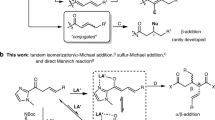Abstract
Asymmetric epoxidation of α,β-unsaturated ketones has been extensively studied and several important procedures have been developed in the last decade. This review addresses the most significant advances in asymmetric epoxidation of α,β-unsaturated ketones using proline-derived α,α-diarylprolinols as catalysts. Special attention has been paid to the enantioselective epoxidation of chalcones, α,β-unsaturated trifluoromethyl, trichloromethyl ketones and β,γ-unsaturated α-keto esters based on the reseach of our group.
Similar content being viewed by others
References
Bonini C, Righi G. A critical outlook and comparison of enantioselective oxidation methodologies of olefins. Tetrahedron, 2002, 58: 4981–5021
Johnson R A, Sharpless K B. In: Ojima I ed. Catalytic Asymmetric Synthesis. New York: VCH, 2000. Chapter 6A
Zhang W, Basak A, Kosugi Y, et al. Enantioselective epoxidation of allylic alcohols by a chiral complex of vanadium: An effective controller system and a rational mechanistic model. Angew Chem Int Ed, 2005, 44: 4389–4391
Zhang W, Yamamoto H. Vanadium-catalyzed asymmetric epoxidation of homoallylic alcohols. J Am Chem Soc, 2007, 129: 286–287
Xia Q H, Ge H Q, Ye C P, et al. Advances in homogeneous and heterogeneous catalytic asymmetric epoxidation. Chem Rev, 2005, 105: 1603–1662
Christmann M. Selective oxidation of aliphatic C-H bonds in the synthesis of complex molecules. Angew Chem Int Ed, 2008, 47: 2740–2742
Shi Y. Organocatalytic asymmetric epoxidation of olefins by chiral ketones. Acc Chem Res, 2004, 37: 488–496
Adam W, Saha-Möller C R, Ganeshpure P A. Synthetic applications of nonmetal catalysts for homogeneous oxidations. Chem Rev, 2001, 101: 3499–3548
Matsunaga S, Qin H, Sugita M, et al. Catalytic asymmetric epoxidation of α, β-unsaturated N-acylpyrroles as monodentate and activated ester equivalent acceptors. Tetrahedron, 2006, 62: 6630–6639
Weitz E, Scheffer A. The impact of alkali hydrogen superoxyde on unsaturated compounds. Ber Dtsch Chem Ges, 1921, 54: 2327–2344
Pluim H, Wynberg H. Catalytic asymmetric induction in oxidation reactions-synthesis of optically-active epoxynaphthoquinones. J Org Chem, 1980, 45: 2498–2502
Juliá S, Guixer J, Masana J, et al. Synthetic enzymes. 2. catalytic asymmetric epoxidation by means of polyamino-acids in a triphase system. J Chem Soc Perkin Trans 1, 1982, 6: 1317–1324
Lattanzi A. Enantioselective epoxidation of α, β-enones promoted by α, α-diphenyl-L-prolinol as bifunctional organocatalyst. Org Lett, 2005, 7: 2579–2582
Liu X Y, Li Y W, Wang G Y, et al. Effective and recyclable dendritic ligands for the enantioselective epoxidation of enones. Tetrahedron: Asymmetry, 2006, 17: 750–755
van Heerbeek R, Kamer P C J, van Leeuwen P W N M, et al. Dendrimers as support for recoverable catalysts and reagents. Chem Rev, 2002, 102: 3717–3756
Dijkstra H P, van Klink G P M, van Koten G. The use of ultra- and nanofiltration techniques in homogeneous catalyst recycling. Acc Chem Res, 2002, 35: 798–810
Fan Q H, Chen Y M, Chen X M, et al. Highly effective and recyclable dendritic BINAP ligands for asymmetric hydrogenation. Chem Commun, 2000, 789–790
Liu X Y, Wu X Y, Chai Z, et al. Highly effective and recyclable dendritic ligands for the enantioselective aryl transfer reactions to aldehydes. J Org Chem, 2005, 70: 7432–7435
Lattanzi A. Bis(3,5-dimethylphenyl)-(S)-pyrrolidin-2-ylmethanol: An improved organocatalyst for the asymmetric epoxidation of α, β-enones. Adv Synth Catal, 2006, 348: 339–346
Lattanzi A, Russo A. Diaryl-2-pyrrolidinemethanols catalyzed enantioselective epoxidation of α, β-enones: New insight into the effect of structural modification of the catalyst on reaction efficiency. Tetrahedron, 2006, 62: 12264–12269
Li Y W, Liu X Y, Zhao G. 4-Substituted-α, α-diaryl-prolinols improve the enantioselective catalytic epoxidation of α, β-enones. J Org Chem, 2007, 72: 288–291
Zheng C W, Li Y W, Yang Y Q, et al. Highly efficient asymmetric epoxidation of electron-deficient α, β-enones and related applications to organic synthesis. Adv Synth Catal, 2009, 351: 1685–1691
Buschmann H H, Antoni T J, Susana Y M, et al. PCT Int Appl 2007 WO 2007000329
Zhang X Q, Li X J, Allan G F, et al. Design, synthesis, and in vivo SAR of a novel series of pyrazolines as potent selective androgen receptor modulators. J Med Chem, 2007, 50: 3857–3869
Druzian J, Zucco C, Rezende M C, et al. Aminolysis of 2,2,2-trichloro-1-arylethanones in aprotic solvents. J Org Chem, 1989, 54: 4767–4771
Yang L, Zheng Q Y, Wang D X, et al. Reversal of nucleophilicity of enamides in water: Control of cyclization pathways by reaction media for the orthogonal synthesis of dihydropyridinone and pyrrolidinone Clausena alkaloids. Org Lett, 2008, 10: 2461–2464
Johansen M B, Leduc A B, Kerr M A. Concise biomimetic total syntheses of both antipodes of balasubramide. Synlett, 2007, 2593–2595
Taniguchi M, Fujii H, Oshima K, et al. Stereoselective reduction of alpha,beta-epoxy ketones with sodium-borohydride in the presence of calcium-chloride or lanthanum chloride-a practical preparation of erythro-α, β-epoxy alcohols. Tetrahedron, 1995, 51: 679–686
Yadav J S, Raju A K, Rao P P, et al. Highly stereoselective synthesis of antitumor agents: Both enantiomers of goniothales diol, altholactone, and isoaltholactone. Tetrahedron: Asymmetry, 2005, 16: 3283–3290
Vilotijevic I, Jamison T F. Epoxide-opening cascades promoted by water. Science, 2007, 317: 1189–1192
Pedro de M, Rolf H. Carbonyl ylides from aldehydes and carbenes. J Am Chem Soc, 1982, 104: 4952
Author information
Authors and Affiliations
Corresponding author
About this article
Cite this article
Zheng, C., Zhao, G. Asymmetric epoxidation of α,β-unsaturated ketones using α,α-diarylprolinols as catalysts. Chin. Sci. Bull. 55, 1712–1722 (2010). https://doi.org/10.1007/s11434-010-3129-0
Received:
Accepted:
Published:
Issue Date:
DOI: https://doi.org/10.1007/s11434-010-3129-0




